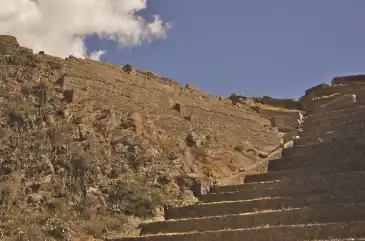Ollantaytambo

In the Sacred Valley of the Incas, through which the Vilcanota River
flows and 70 kilometers northeast of the city of Cusco, the Incas
captured their imperial significance in one of the most fabulous
architectural complexes: Ollantaytambo.
Its location between the Inca
capital and the jungle, "a particularly useful node in the route
network", provided it with a strategic military position, as well as for
state administration and control of the exchange of goods. Precisely
that function was assigned to it by the Inca Wiracocha when he founded a
tambo there, Ollantay, which was a place of transit, of temporary
residence.
It was Pachacutec, the first sovereign of the Hanan
dynasty, who changed the destiny of Ollantaytambo and the history of
ancient Peru. He ordered the tambo to be set on fire as a symbol of the
end of the Hurin dynasty, to which Wiracocha Inca belonged, and rebuilt
it to the extent of its imperial projection.
Ollantaytambo is the
axis between MacchuPicchu and Cusco. It is the most strategic center of
the valley and was considered the second most important city after
Cusco. It was also the center of exchange for products such as coca
leaves and corn, in a barter system between the towns near the edge of
the jungle and with those in the mountains. This place has 600 hectares
of archaeological sites that the Incas built along their valleys. Thus,
when visiting one of these places you could see terraces, temples,
granaries and aqueducts that came down from lagoons or streams with the
final purpose of irrigating the terraces in the form of pyramids, along
the slopes of the mountains.
In this enormous complex, the Incas
reiterate their genius in the use of "lithic technology on an
architectural scale." It is made up of several ceremonial sites such as
the Temple to Water, the Ñusta bath, and the Temple of the Sun with its
enormous monoliths, among others. In addition, buildings dedicated to
astronomical observation, administrative functions, urban, livestock and
agricultural areas.